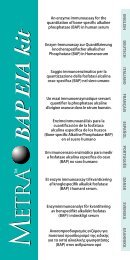Clinical and Technical Review - Tecomedical
Clinical and Technical Review - Tecomedical
Clinical and Technical Review - Tecomedical
You also want an ePaper? Increase the reach of your titles
YUMPU automatically turns print PDFs into web optimized ePapers that Google loves.
20<br />
Measurement of BAP <strong>and</strong> Osteocalcin<br />
in cell culture<br />
• DMEM or equivalent commercial medium<br />
• Fetal bovine serum or calf serum or serum substitutes<br />
(FCS free medium)<br />
• L-Glutamine or Ascorbat<br />
• Antibiotic<br />
Additionally, 50 nM Vitamin D3 is necessary to generate<br />
measurable quantities of osteocalcin. The cells can be<br />
grown in serum containing media, but osteocalcin must be<br />
harvested from tissue culture supernatant that is serumfree,<br />
because the antibody will also detect this analyte in<br />
serum.<br />
Bone alkaline phosphatase is membrane-bound <strong>and</strong> it has<br />
to be measured in culture from cell lysate. Cell culture media<br />
should not be treated with ion chelators like EDTA or citrate<br />
because of an inhibition of the BAP enzyme activity.<br />
After the incubation the cell layers should be washed twice<br />
with saline <strong>and</strong> scraped into TMN buffer solution (20 mM<br />
Tris-HCl, pH 7.4; 2 mM MgCl2; 150 mM NaCl) uising a stir<br />
stick. The number of cells has to be determined (e.g. Coulter<br />
cell counter Model F) before the cells become solubilized by<br />
the addition of Triton X-100 to a final concentration of 1 %.<br />
Centrifugate the samples at 70,000g for 60 min <strong>and</strong> examine<br />
the aliquots of the supernatant for alkaline phosphatase<br />
activity.<br />
Sheep <strong>and</strong> human cells will be fine for this purpose.<br />
References for BAP, PICP, OSTEOCALCIN<br />
in cell culture<br />
Kaspar D, Seidl W, Neidlinger-Wilke C, Ignatius A, Claes L<br />
(2000) Dynamic cell stretching increases human osteoblast<br />
proliferation <strong>and</strong> CICP synthesis but decreases osteocalcin<br />
synthesis <strong>and</strong> alkaline phosphatase activity.<br />
J Biomech 33, 45-51.<br />
Martínez ME, Medina S, Del Campo MT, et al. (1998) Effect<br />
of polyethylene on osteocalcin, alkaline phosphatase <strong>and</strong><br />
procollagen secretion by human osteoblastic cells.<br />
Calcif Tissue Int 62, 453-456.<br />
Measurement of CICP / PICP<br />
in cell culture<br />
The assay is suitable for the measurement of cell culture<br />
supernatant from cells producing type-I collagen. The<br />
METRA ® CICP Test can be used for the determination of the<br />
collagen production level of skin fibroblasts <strong>and</strong> bone cells.<br />
It is recommended, that the supernatant of these cultures<br />
contains serum-free medium. Bovine serum in the medium<br />
may contain bovine CICP, which cross-reacts with the antibody<br />
in the kit. This would result in erroneously increased<br />
values.<br />
In a confluating cell culture at an optimal collagen production<br />
level, the amount of CICP in the supernatant is approximately<br />
20 – 50 ng/ml or slightly below a normal human serum<br />
sample. Dilute the cell culture supernatant 1:12 (like a normal<br />
serum sample) <strong>and</strong> calculate the final concentration according<br />
to the dilution. If the CICP concentration of the 1:12<br />
dilution is below the detection limit it is possible to choose<br />
a 1:6-dilution.<br />
Sell S, Gaissmaier C, Fritz J et al. (1998) Different behavior<br />
of human osteoblast-like cells isolated from normal <strong>and</strong><br />
heterotopic bone in vitro. Calcif Tissue Int 62, 51-59.<br />
Siggelkow H, Niedhart C, Kurre W, et al. (1998) In vitro differentiation<br />
potential of a new human osteosarcoma cell line<br />
(HOS 58). Differentiation 63, 81-91.<br />
Siggelkow H, Rebenstorff K, Kurre W, et al. (1999)<br />
Development of the osteoblast phenotype in primary human<br />
osteoblasts in culture: comparison with rat calvarial cells in<br />
osteoblast differentiation. J Cell Biochem 75, 22-35.



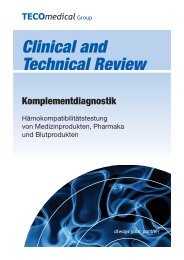
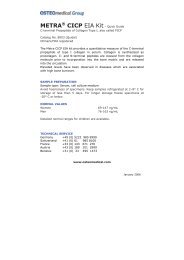
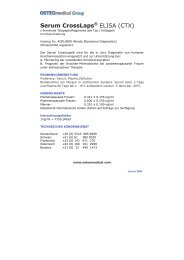
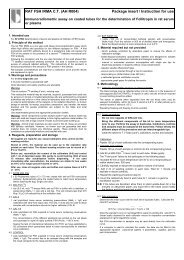


![PTH [Hormone Parathyroïdienne] Intacte ELISA](https://img.yumpu.com/1233682/1/190x245/pth-hormone-parathyroidienne-intacte-elisa.jpg?quality=85)
